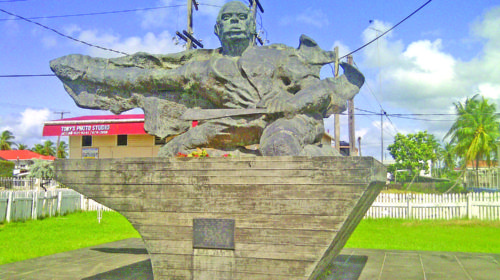

 By Kizzy Coleman
By Kizzy Coleman
Emancipation day is observed annually in Guyana to memorialise the ending of slavery of

the African people and celebrate their freedom from servitude.
August, 1, 1838 was one of the most important days of the country’s history: it brought an end to a European institution deliberately designed to acquire wealth from the “sweat” of Africans through forced labour.
But on August 1. 1838, the people forced into enslavement were finally freed from anguish and poverty and were free to live – to really live. However, being free did not mean Afro-Guyanese forgot the struggles that they endured to acquire that freedom; as such, monuments were erected to stand as reminder of what was fought for.
A monument is a structure erected to commemorate a historical event in history or significant figures that contributed greatly to some major historic event.
There are a number of emancipation monuments erected throughout Guyana over the years, to remind of how grateful Guyanese should be towards those who came before us and fought for what we are able to realise today.
One of these is the 1823 Emancipation Monument, designed and built by US-based Guyanese sculptor Ivor Thom.
Located along the Seawall Road opposite the Guyana Defence Force’s Camp Ayanganna headquarters, it was unveiled August 5, 2013 to remind Guyanese of the largest revolt in its history, which took place exclusively on the East Coast of Demerara.
The 1823 revolt is of historic significance because it was the largest slave revolt in Guyana’s history, with over 10,000 slaves being involved. It is said that it also helped to hasten the decision for emancipation.
Occupying the southern side of the grand base of the monument is the figure of a woman armed with a machete. There is no fear in her piercing eyes but rather a striking look of determination. On the opposite side is the equally fearless figure of a man holding a musket in one hand, demanding his people’s freedom.
The 1834 Monument or the Damon Monument immortalises Damon, an enslaved African who was executed for his role in the protest against a new system of apprenticeship on August 8, 1834.
He had led a group on a strike, declaring their decision to work only half day, as opposed to all day, which they were doing for many years. Acting as the leader of the people, Damon hoisted a flag in the Trinity churchyard at La Belle Alliance. For his role in the protest, this hero was hanged.
The Damon Monument, erected in 1988, honours his existence and the role he played, and serves to remind Essequibians of the struggles of their forefathers in that region. This monument, which was financed through government funding, was also designed and built by Ivor Thom.
This monument of Damon is a giant chair, sculpted of bronze, weighs three tons and stands nine feet tall. It rests on a concrete plinth. It was unveiled at Anna Regina, Essequibo Coast on the 150th anniversary of emancipation celebrations on July 31, 1988 at Damon Park.
The Beterverwagting Monument is a striking structure showing a hand with a broken chain, clutching a book which represents the registered title to the property in which the village was founded.
Beterverwagting, called ‘BV’, was bought by 62 slaves for the sum of $52,000 from Baron Van Gronigen. This community now houses almost 20,000 people and measures a half-mile by eight miles in extent.
The village of Victoria was also bought by slaves, 83 of them who pooled their finances. To mark the significance of the purchase, the Victoria Emancipation Monument was erected.
The clay brick monument still stands in the Victoria Culture Centre Yard. It continues to pay tribute to those who purchased the plantation. It is now more than 170 years since the village was purchased by the slaves.
There are a number of other monuments that were erected to memorialize this time in Guyana’s history. These include monuments such as the Ann’s Grove and Two Friends Centenary Monument, the Golden Grove Centenary Monument, the Lichfield Centenary Monument, Nabaclis 150th Anniversary Monument, the Friendship Emancipation Monument, the Kildonan Independence Monument and the Plaisance Independence Monument, and the most well-known, the 1763 “Cuffy” Monument.



